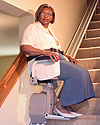A Look at How to Make the Stairs Safer for Seniors
Published by Stephen on May 5, 2010 Under stair lifts For a senior, especially one with arthritis, using the stairs can often be quite difficult. Falls are very common and staircase falls are actually the leading cause of senior hospitalization. This makes ensuring that the elderly can safely use the stairs essential, which means evaluating the senior’s abilities and needs, to determine if they can safely use the stairs on their own, should install a stair lift, or would be better suited avoiding the stairs all together.
For a senior, especially one with arthritis, using the stairs can often be quite difficult. Falls are very common and staircase falls are actually the leading cause of senior hospitalization. This makes ensuring that the elderly can safely use the stairs essential, which means evaluating the senior’s abilities and needs, to determine if they can safely use the stairs on their own, should install a stair lift, or would be better suited avoiding the stairs all together.
It is common for arthritis to cause seniors to have difficulty using the stairs, which can occur in those with knee arthritis that makes them unable to safely lift their legs, as well as wrist or hand arthritis that can make holding the handrail more difficult. However, there are many other conditions, such as poor vision attributed to glaucoma or mental conditions, such as dementia, that can make using the stairs very difficult. So, it is very important to help determine what the senior can safely do on their own and how these types of conditions affect their daily life. Evaluating their abilities is typically the first step and will help determine what method of action is best for their situations.
In some cases, simply ensuring that the stairs are well lit, there are handrails on both sides, and brightly colored grip-tape is present on the stairs can provide an effective means of reducing the risk of a senior fall on the stairs. In the case of using grip tape, it is a good idea to make sure that the top step and the bottom step are differently colored than the other steps. This way, the color change will provide an indicator that the staircase is ending and will help to reduce the risk of a staircase fall.
 However, there are many seniors who need more than just dual handrails and colored grip tape to be able to safely use the stairs, especially those who have arthritis or other medical conditions that make it difficult for them to get around. In instances like this, a stair lift or some other sort of staircase safety tool may be a good choice. A stair lift is used to help make it easier for the senior to move up and down the stairs, as it provides a motorized chair or small platform that actually carries the senior up the staircase and back down again.
However, there are many seniors who need more than just dual handrails and colored grip tape to be able to safely use the stairs, especially those who have arthritis or other medical conditions that make it difficult for them to get around. In instances like this, a stair lift or some other sort of staircase safety tool may be a good choice. A stair lift is used to help make it easier for the senior to move up and down the stairs, as it provides a motorized chair or small platform that actually carries the senior up the staircase and back down again.
The stair chair, which is the most common and safest type of stair lift, provides a plastic chair that moves along the stair lifts track. The senior can sit in the chair and push the button on the chairs armrest or hand control, which will then carry them up or down the stairs. Most also include multiple wireless remote controls that can be affixed to the top and bottom of the stairs, working in a manner similar to the call buttons on an elevator.
A perch lift, or standing stair lift, is much less common and allows the senior to step onto a small platform to be carried up the staircase. The small platform, often called a perch, means that the senior must remain upright and in a standing position as the stairlift moves up the stairs, which is why these types of stair lifts are not as safe as others. However, in areas with very limited space or if the senior has had a hip or knee replacement, a standing stair lift may be a good choice.
In many cases, simply ensuring that basic safety and preventative measures are in place, such as installing a stair lift or upgrading the handrails, will be enough to greatly reduce the risk of a senior fall, but these methods are not for everyone. This is where carefully evaluating the abilities of the senior comes in, because if they are found to be unable to safely use a stair lift or the stairs, than it is usually best to simply avoid them all together. Of course, avoiding the stairs is something that is oft easier said than done, sometimes involving moving to a new home or living community, but when safety and health is at stake, no move is too much.
No Comments |
Add a Comment